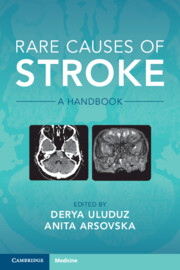Book contents
- Rare Causes of Stroke
- Rare Causes of Stroke
- Copyright page
- Contents
- Contributors
- Preface
- 1 Inflammatory Conditions
- 2 Infectious and Postinfectious Vasculitis
- 3 Hypercoagulable Causes of Stroke
- 4 Drug-Related Stroke
- 5 Hereditary and Genetic Causes of Stroke
- 6 Rare Causes of Cardioembolism
- 7 Vasospastic Conditions and Other Vasculopathies
- 8 Other Non-inflammatory Vasculopathies
- Chapter 8.1 Moyamoya Disease
- Chapter 8.2 Cerebral Amyloid Angiopathy
- Chapter 8.3 Dolichoectasia and Fusiform Aneurysms
- Chapter 8.4 Carotid Artery Dissection
- 9 Venous Occlusive Conditions
- 10 Bone Disorders and Stroke
- Index
- References
Chapter 8.4 - Carotid Artery Dissection
from 8 - Other Non-inflammatory Vasculopathies
Published online by Cambridge University Press: 06 October 2022
- Rare Causes of Stroke
- Rare Causes of Stroke
- Copyright page
- Contents
- Contributors
- Preface
- 1 Inflammatory Conditions
- 2 Infectious and Postinfectious Vasculitis
- 3 Hypercoagulable Causes of Stroke
- 4 Drug-Related Stroke
- 5 Hereditary and Genetic Causes of Stroke
- 6 Rare Causes of Cardioembolism
- 7 Vasospastic Conditions and Other Vasculopathies
- 8 Other Non-inflammatory Vasculopathies
- Chapter 8.1 Moyamoya Disease
- Chapter 8.2 Cerebral Amyloid Angiopathy
- Chapter 8.3 Dolichoectasia and Fusiform Aneurysms
- Chapter 8.4 Carotid Artery Dissection
- 9 Venous Occlusive Conditions
- 10 Bone Disorders and Stroke
- Index
- References
Summary
Carotid dissection is found to be as high as 20% in stroke patients younger than 30 years of age. The most common presenting symptom (80-90%) is unilateral headache at the same side of the arterial dissection. We present a 17 year-old male that was admitted to the emergency department with a headache. Bilateral carotid ultrasound with color doppler was suspicious of right carotid artery dissection at the cervical segment, so digital substraction angiography was performed to verify the dissection. On digital substraction angiography, right internal carotid artery was found to thin out and go out of existence at 2-3 cm proximal of the bulbar segment that was compatible with dissection
- Type
- Chapter
- Information
- Rare Causes of StrokeA Handbook, pp. 326 - 330Publisher: Cambridge University PressPrint publication year: 2022

